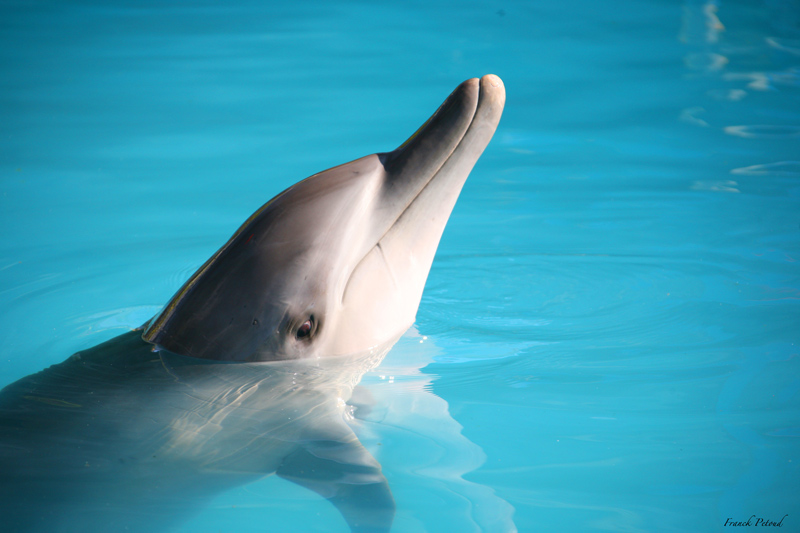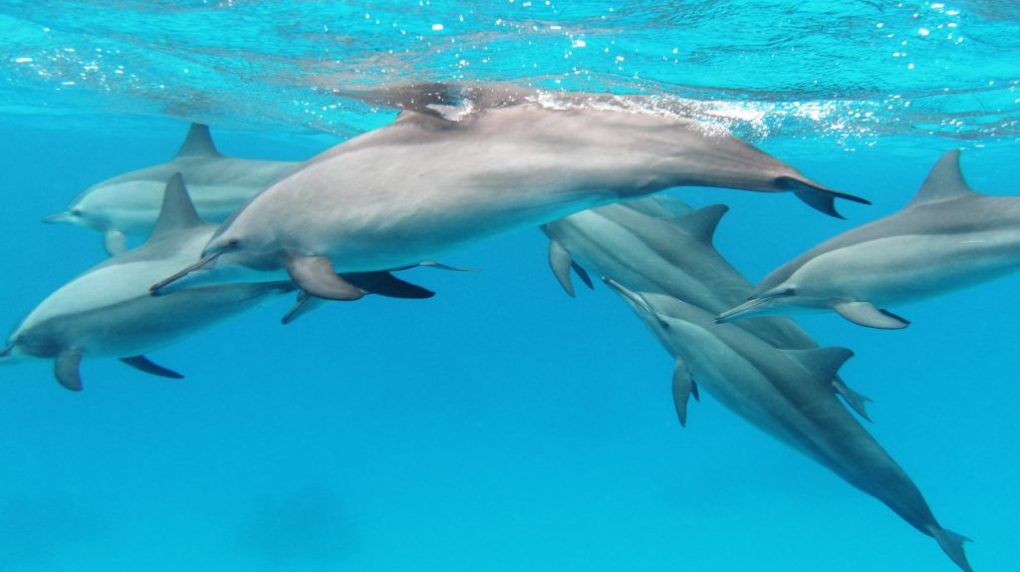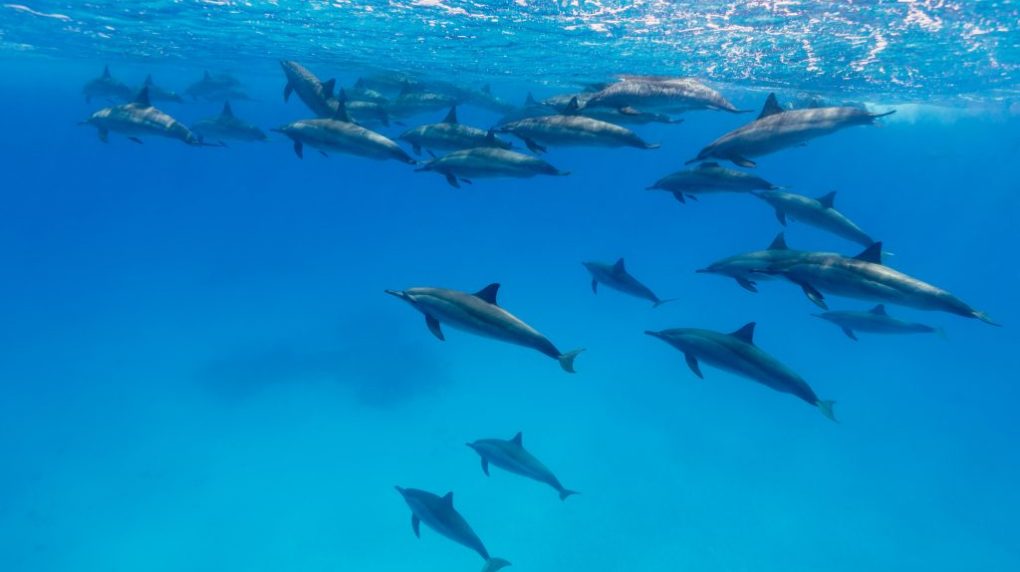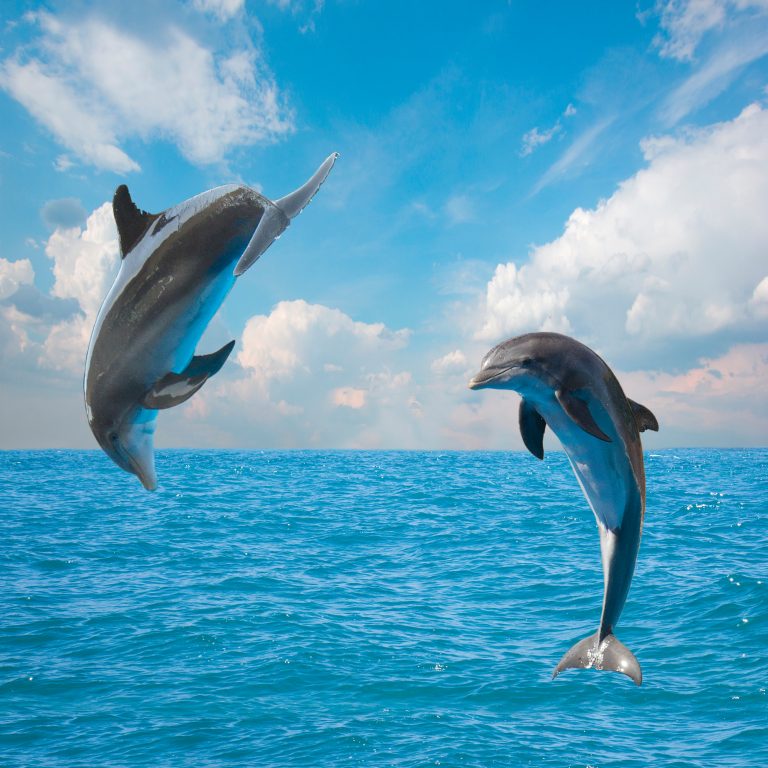HAWAIIAN NAME: NAI’A
Spinner dolphins average 6 feet in length and around 175 pounds . Pod size ranges between 10-100 individual dolphins. Hawaiian Spinner Dolphins have been making their mark in Hawaiian folk lore, and American Novels like Herman Melville’s Moby Dick and Mark Twain’s Roughing It. They have been at home on the west side of Oahu since well before recorded time. In Hawaii, Spinner (Nai`a) dolphins swimming near approaching ships is common, Hawaii’s oceanic “Ambassadors of Aloha.” There is some belief that Native Hawaiians deemed dolphins to be an oceanic tribe with equal rights as human villagers. They work cooperatively with them to fish even to this day.
Spinner Dolphins swimming along near Ko’olina are seen daily on the west side of Oahu. They travel off shore at night to their feeding grounds and return to the shoreline in shallow waters to socialize, nurse their young, and rest.

HOW DO DOLPHINS FEED?

The spinner dolphin feeds mainly on small fish, squids, and shrimps, and will dive 200–300 m to feed on them. During the night, a deep-sea community of marine life that spends daylight hours at depths of up to 3,000 feet, now begins to migrate upward and towards the shore. As these riches come within reach, spinner dolphins swimming begin to hunt. Oahu Spinner dolphins swim to forage at night and cooperatively herd their prey into highly dense patches. They swim around the prey in a circle and a pair may swim through the circle to make a catch.
Using echolocation, the Spinners scan the darkness and using their whistles, they call members of the school back together after the hunt or to unite in defense from harm. By dawn, the Spinner dolphins swim together and regroup. Well-fed, they move once again towards the shelter of the islands.
Mornings are a time of celebration as the members of the school meet, and play together. Youngsters practice their lessons. Much affectionate touching and rubbing occurs now. Some dolphins swimming around engage in games like swimming underneath another while scissoring their pectoral fins back and forth, others “hold hands,” and some caress each other with their tail flukes. These behaviors increase and affirm social bonds.
HOW DO DOLPHINS SLEEP?

As the dolphins enter a resting state — the school tightens up, synchronizes its breathing, and begins to prepare for sleep. The subgroups of the school move closer together. Groups of adult male dolphins swim and move alongside groups of females and small calves. The warm, clear waters entice them to rest, the dolphins draw closer. Together they rise and fall from the surface until each spinner slips into sleep, swimming with dolphin friends all around.
This period of rest does not resemble sleep as we know it. The dolphins are not actually unconscious as only parts of their brains are asleep at any one time. The Spinner dolphins swimming still have turned their sonar off, without sound, they rely heavily on sight. Therefore, clear water and white-sand bottoms are so important to them.
As the Spinners awaken from their rest, some members begin to slap their heads on the surface, urging the school of dolphins swimming in shallow waters . But other members are reluctant to leave just yet, and slowly nudge the school back into the shallows, back into resting behavior. For the next hour or more, the spinners perform this zig-zag pattern. Slapping their heads or spinning airborne, moving out, then quieting down and drifting back toward shore. Finally, they head offshore for another night of hunting.
WHY DO SPINNER DOLPHIN'S SPIN?
here are different patterns of “spins” performed by the Spinner dolphin swimming along. Early indicators of arousal from resting schools are head slaps, thrusting their nose out of the water as they move slowly at the surface, and splashed back against the surface as it snaps its head downward. Another common pattern are tail slaps, and multiple fast tail slaps called “motorboating”. This pattern is associated with dolphins swimming to feed.
If the school is on the move or accelerating you will see an increase in head and back slaps, where the dolphins swimming then emerge from the water about mid-body and then slaps its belly or rotates and slaps it’s back against the water.
What Spinner Dolphins are most famous for are their signature spins. These spins usually occur when Spinner dolphins are most aroused/active, and spread apart from one another. Dolphins swimming in schools are spread out the most during feeding and this is when the most observed spinning and high-energy behavior occurs most constantly.
There seem to be two major functions of aerial spins. The more acrobatic spins may serve to dislodge Remoras or other parasites. Other types of spins that cause a greater amount of sound or splash, (causing bubble trails), when re-entering the water might be a form of location recognition. Locating where certain dolphins swimming in the group, and where the edge of the school can be identified.
Resource: The Hawaiian Spinner Dolphin by Kenneth S. Norris et al.

